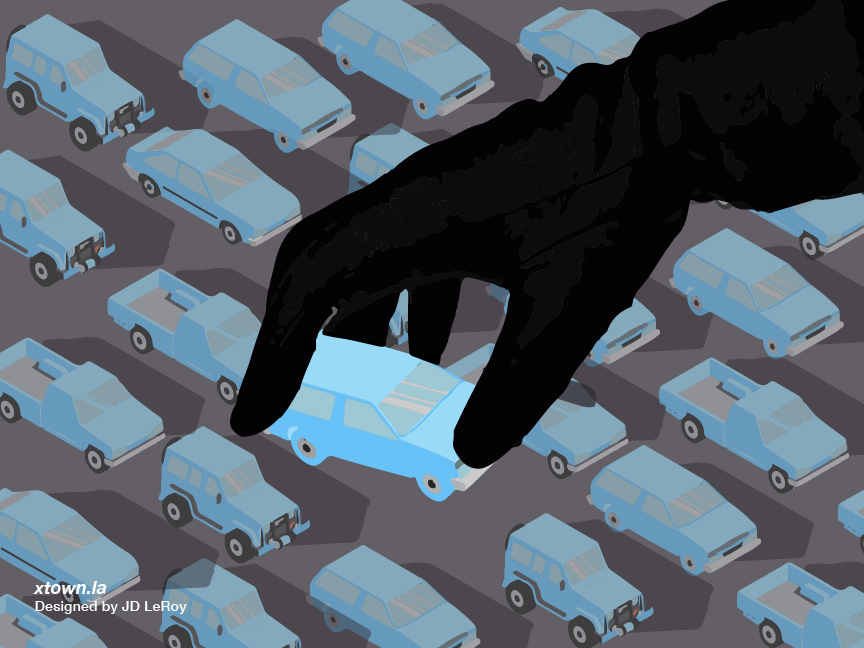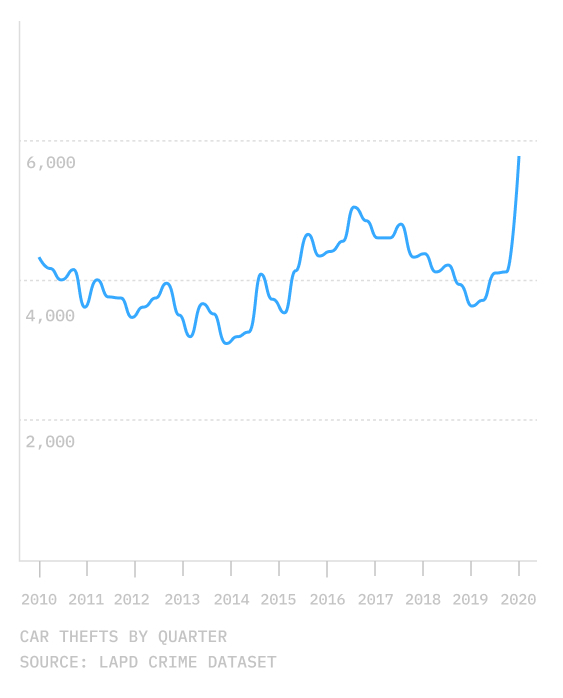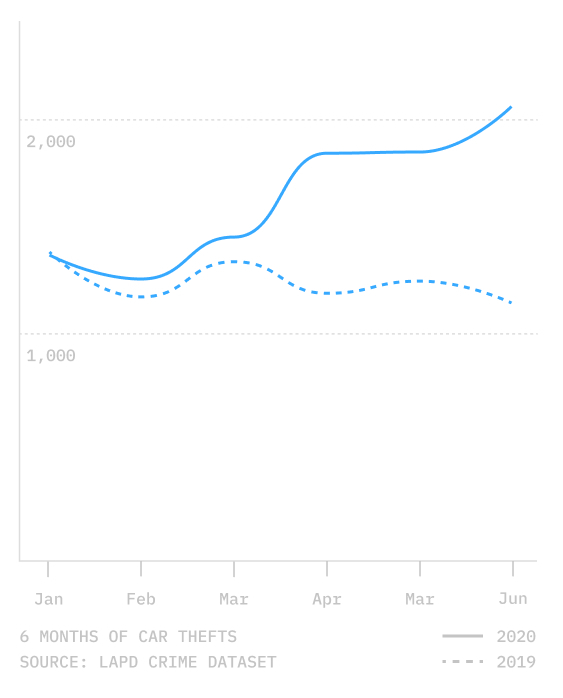COVID-19 leads to a spike in car thefts

Car thefts in Los Angeles soared to a record high in the second quarter of 2020. A Crosstown analysis of Los Angeles Police Department data revealed that 5,744 vehicles were stolen from April-June, up 57.7% from the same period last year.
The spike coincides with the arrival of the coronavirus pandemic. Although crime in general has decreased since mid-March, when schools were closed and businesses were shuttered in the effort to slow the spread of the COVID-19 virus, vehicle thefts have spiked. As Crosstown reported last month, April saw a 31% jump in car thefts, and the numbers have only climbed since then.
It’s a stark contrast to the first quarter of the year, which registered only a slight increase over January-March of 2019. Yet in June, there were 2,055 vehicles stolen, nearly double the 1,167 reported in the same month last year. There were more auto thefts between April-June than during any quarter since the LAPD began making its data public over a decade ago.
A decade of vehicle theft in Los Angeles

Graphics by JD LeRoy
The top neighborhoods for car theft this year are Boyle Heights, with 327 incidents, Sun Valley with 304, and Van Nuys with 293.
The COVID-19 car theft connection
The rise in thefts marks a break with the past decade. In the first half of the 2010s, there were rarely more than 4,000 vehicles reported taken during any three-month period. Figures then began increasing, and in the fourth quarter of 2016 that number peaked at 5,098. Since then car thefts have declined steadily.
Until now. Law enforcement officials say the pandemic has created new opportunities for car thieves, with many Angelenos leaving their vehicles parked on the streets for extended periods. This is in part because fewer people are leaving their home for work, and also because the city has not been ticketing for violations such as street sweeping.
Car thefts spiked this year during the COVID-19 shutdown

Another factor, according to the police, may be the “zero bail” policy in Los Angeles. The policy, passed on March 27 in Los Angeles County in an effort to reduce the spread of coronavirus in jails, eliminated the bail requirement for low-level felonies and misdemeanors.
“People are seeing that they’re not going to stay in jail, especially for car theft,” said LAPD Lieutenant Siage Hosea, who works on the Task Force for Regional Autotheft Protection. “So what’s happening is we are seeing repeat offenders.”
In one instance, a man was arrested three times in one day for stealing a car, with the last incident ending in a pursuit near La Puente.
‘Like an Uber’
Although some cars are taken and their parts sold, Hosea said most of the stolen cars he’s come across are recovered close to where they went missing.
“People are just using them for transportation. They’re taking one car here, and then drive over there,” he said. “Like an Uber.”
In many instances, the theft involves far more inconvenience than a vehicle being recovered a few blocks away. According to the Insurance Information Institute, the average car theft costs $8,407. In 2018, about $6 billion was lost to motor vehicle theft nationwide, according to the Institute.
Los Angeles resident Blanca Perez experienced the frustration when her father’s car was stolen on June 30. The Honda Accord was taken from the Historic South-Central neighborhood, and when it was recovered a week later, the vehicle was damaged and items were missing.
“The vehicle had a messed-up ignition, and they stole my father’s wallet and over $300 worth of tools from his trunk,” Perez said. “It was recovered in East Los Angeles without any gas and they took off one of the headlights, too.”
To protect yourself from car thieves, Hosea recommends parking your car where you can see it, installing a new alarm if the vehicle is older and utilizing a steering wheel lock.
How we did it: We examined publicly available LAPD data on reports of auto theft from Jan. 1 2010 – June 30, 2020. For neighborhood boundaries, we rely on the borders defined by the Los Angeles Times. Learn more about our data here.
LAPD data only reflects crimes that are reported to the department, not how many crimes actually occurred. In making our calculations, we rely on the data the LAPD makes publicly available. LAPD may update past crime reports with new information, or recategorize past reports. Those revised reports do not always automatically become part of the public database.
Want to know how your neighborhood fares? Or simply just interested in our data? Email us at askus@xtown.la.






